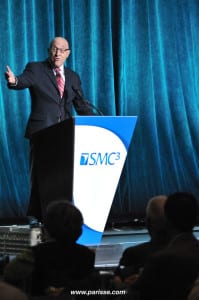
Knowing how and when to hit the reset button is an often over-looked skill that is critical to the craft of public speaking.
Have you ever sat in an audience where the speaker wasn’t connecting – not because the content was off, but because the speaker’s energy level was out of sync with the audience’s?
We were – last week. It was a magic show complete with lighting, levitation, and illusions. The magician was a larger than life performer, with tone, gestures, and pacing identical to the show he does in Las Vegas. The performance should have been a home run, but it wasn’t.
The issue? The show wasn’t in Vegas. It was at a retirement community we were visiting where an 8:00 PM show start time is considered “a little late”. The audience, full from its’ pre-show dinner, was stone cold sober in all senses of the word. Yet, the magician played with Vegas-like energy. He couldn’t dial it down to meet the audience, establish connection, and lift them up. It was an epic fail because he couldn’t hit the reset button.
If this happened to you, could you press the reset button?
In our speaker coaching programs, we train presenters to rehearse solutions to disaster scenarios.
Two options for hitting the reset button for you to practice:
Scenario 1: There’s a delta between your energy and the audience’s:
Pause, look at the audience, and shift your tone so it’s just above their’s. Then bring them up as quickly as they can accept.
Scenario 2: The content you’re presenting isn’t resonating:
Notice you’re out of sync and change it up. Shift your body position, darken the PowerPoint, pause for a beat and say something like “you know, let’s just talk.” Then relax and have a conversation.
The single most important thing to remember:
Pay attention to the audience’s tone level and adjust yours as needed.
Be observant. If there’s a sudden coughing outbreak spreading throughout the room, extra light from cell phone screens, or people sneaking out of the room, hit the reset button to re-engage your audience and re-track your presentation.
Learn how to hit your reset button at The Speaking Intensive℠. Get 18 hours of coaching with us in a small group setting for half the cost of our private coaching retainer. Register for the April 27-28 small group coaching session to join us. Save money by taking advantage of the early registration discount before it ends on March 3rd, if the session isn’t sold out by then.

There are two types of speakers in this world: those who get nervous and those who are liars.
… Mark Twain
At The Speaking Intensive℠ one of the first topics we work with is how to manage nerves when speaking. While we explore many different strategies, this blog highlights 2 of them.
To keep ourselves in good speaking shape, we work out with a trainer. A former pro-football player, he’s taller than either of us can jump and wider than both of us standing shoulder to shoulder. Our trainer, let’s call him “Iron Man”, is fierce. Imagine our surprise when, after a tough workout, Ironman shyly said –
“You train speakers and I have to speak in front of audiences. It terrifies me. What can I do about overcoming nerves before speaking?”
Interesting comment from an NFL player.
Lisa’s response to Ironman:
“You can’t overcome nerves … and why would you want to? Remember the nervousness you felt before a big game when you were about to take the field? Did you run away? No!
Those nerves energized you. Made you even more determined. You trusted your training and preparation. You focused on doing your job.
The same goes for managing nerves when speaking. It’s the same thing!”
Alan’s response:
“George Plimpton was the master of what he called ‘participatory journalism.’ When he wanted to write about sports, comedy or performance, he did it first.
Boxing? He stepped in the ring with Archie Moore, a world light-heavyweight champion. Football? He trained with the Detroit Lions. Comedy? He did standup at Caesar’s Palace. Music? In what for him was the scariest moment, he ‘crashed the cymbals’ for Leonard Bernstein and the New York Philharmonic.
Plimpton was struck by the similarity in the nervous energy all kinds of performers had before they went on.
Bottom line: Successful performers come to know that nervousness is the fuel of a great performance.
If you’re nervous before you speak, reframe it as energy and aliveness. Then go out and do your job … what you know to do … what you’ve been trained to do.”
How does Lisa manage nerves before speaking?
“Back in the skating days, I’d throw up before a performance. No Nerves … No Nausea … Bad Skate”.
Today Lisa still gets nervous but has replaced the spewing with physical activity to make nerves work for her. Jumping jacks, air-boxing and yogic breathing wring out the frenetic nay-saying nerves and make space for the crucial productive nerves that fuel her presentations.
Alan Parisse, Hall of Fame speaker, named One of the Top 21 Speakers for the 21st Century doesn’t get nervous, right?
“Wrong. This duck is paddling hard under the water.
I get nervous but don’t let that little voice in back of my head talk me down. I thank the voice for it’s opinion but don’t buy in. Instead, I trust my preparation and use those nerves to fuel my presentation.”
There are many strategies for managing nerves when speaking. Start with these 2 and you’ll be on your way!
- Get physical! Convert sabotaging nerves into nerves that fuel your performance.
- Don’t buy into “the voice”. Instead trust your preparation.
Learn more techniques for managing nerves when speaking and so much more at The Speaking Intensive℠. You’ll get 18 hours of coaching with us in a small group setting for half the cost of our private coaching retainer.
It’s a no-brainer! Register for a group session below.
Already graduated from The Speaking Intensive℠ and want to participate again? The repeater record stands at 4 times! Call us for your special repeater rate.
P.S. – Did you find this post helpful? Please share it with your friends, family, and colleagues!

What is the #1 best way to present from behind the lectern? Take a half-step back. One that is wide enough to put some distance between the lectern and you, yet close enough to maintain visual contact with your notes and vocal contact with the microphone, unless you are wearing one.
Since we intuitively knew to step back from the lectern, Lisa and I thought this was an inconsequential piece of knowledge everyone knew. Then came a series of wholesaler trainings for a large global financial services firm. They came to us a coaches’ dream team: strong, well-trained presenters who wanted to get even better. Yet something seemed to fall apart when the lectern was introduced. As Lisa was working with their choreography behind the lectern, one of our participants shouted out “take a half-step back”. SHAZAAM! It all became clear … and it works.
Taking a half-step back is absolutely the #1 best way to present from behind a lectern because it gives you the best of both worlds: the credibility that can come from being behind the lectern and having room to gesture and move.
Two Common Pitfalls of Presenting Behind a Lectern:
- The Crutch: Lecterns are often used as a place for nervous speakers to hide. In The Speaking Intensive presenter development program, we work to bring speakers out from behind the lectern so they gain the comfort and experience necessary to have a choice about when to most effectively in front of a room.
- The Hate: “I never go behind the lectern. I hate them.” Ok, but what will you do if there is no choice and you are stuck behind one? How about if the situation is sufficiently grave or consequential that you need a place to put your detailed notes or a script?
3 Mistakes Lectern Presenters Make:
Stepping back will also help cure common mistakes presenters make behind a lectern.
- The Hug: If you’ve ever witnessed “the hug”, then you know what I’m talking about. The presenter’s arms placed on either side of the lectern, elbows out, as if latching on to a long lost friend. Huggers appear hunched over, somehow weakened.
- The Death Grip: Is a description really necessary here? Gripping the lectern until your knuckles turn white is not compelling to an audience. If the audience isn’t engaged, the sweaty imprint of your hand is all that will be left as evidence you were ever there.
- Dancing Feet: Speaking is a full body sport. That’s obviously true when you are standing clear of the lectern, and it is also true behind a lectern. A sloppy stance will sap your credibility even when the audience can’t see your lower body. They will sense something is not quite right, but won’t know why.
Each of these correctable conditions chips away at your credibility and can cause the audience to disconnect. No matter how compelling your presentation may be, audiences won’t fully buy-in if your body doesn’t support your message.
A “SHORT” NOTE:
If you are as short as I am, find something to stand on. I’ve used a milk crate (shaky), a commercial dishwasher glass rack (more stable – but not suitable for some shoes) and anything else I could find. You want to see the audience and for them to see you. You certainly don’t want them wondering where that voice is coming from.
Sure, lecterns are kind of old school, but they add an aura of authority to you and your message and can even be an effective tool when used correctly. Presenters who learn how to leverage the lectern increase their range of audience connection.
Join us at The Speaking Intensive. Presenters from The Chicago Bulls, Merrill Lynch, JP Morgan, Allianz, LPL, Rockwell Collins and 40 other firms already have. Now it’s your turn. Just 1 seat left in the August session. Catch the early registration discount for the October session!
 Don’t let your audience or hosts “capture” you and ruin your presentation.
Don’t let your audience or hosts “capture” you and ruin your presentation.
Great speaking starts with moving from the all too common mindset of Here I Am – my ideas, my thoughts, my goals, my objectives – to coming from a place of There You Are, where you can focus on the audience’s ideas, thoughts, goals and objectives. Yet, like most good things, you can take it too far and become so focused on your host or the audience that you lose your point of view.
We call it Audience Capture and it’s similar to Regulatory Capture. That’s where regulators like the Federal Reserve Board become so close to those they are supposed to regulate that they fail to do their jobs completely. Something similar happens when speakers become so focused on what their host or audience wants that they lose their energy, passion and message.
This is risky business for speakers. Your job is deliver a compelling talk to the audience in a way that creates action. While you should begin with an attitude of There You Are, shifting 100% of your attention to what others want risks the dilution of your message. The end result will likely not be as persuasive.
It can also happen in one-to-one conversations. Think about it. Have you ever had a one-to-one conversation where you set aside or modified your opinion or belief so that you could be more relatable to the person with whom you were speaking? Let’s call this Conversation Capture. Three of the reasons this happens are that we want the other person to:
1. Like us.
2. Agree with us.
3. Support us or sign an agreement.
If we do this consciously, it’s one thing. Oftentimes, however, we do it unconsciously and that’s risky business.
By setting your opinion or belief aside, you may not be perceived as someone with valuable thoughts and ideas. You will have entered the desert of wishy-washiness.
Now, take that one-to-one conversation and change it to one-to-many. That’s you giving a presentation to an audience of more than one person. If you fall victims to audience capture, you’ve more than entered that desert. You’re alone riding a dusty camel in the hot sun seeking an oasis.
So how do you avoid audience capture? Find the sweet spot between there you are and here I am. Acknowledge that there may be aspects of your talk that not everyone can relate to or agree with. Use stories and other techniques to overcome those deltas. The audience will respect you for paying attention to their needs and, even better, be more likely to buy into what you are selling.
The difference between winning and losing the deal often comes down to how information is presented. Do more than just wing it! Join The Speaking Intensive to learn more proven techniques from my career raising capital and as a Hall of Fame speaker.
“Transformational. A professional breakthrough.”
“Fantastic!! Ultimately a straight route to improve my impact and influence.”
“As much a Leadership Development experience as a Public Speaking course.”
“Thank you for pushing me to tap into “tools” I didn’t know I had.”
“Definitely the best program I’ve ever attended.”
© Copyright 2014 The Parisse Group, Inc.

“The Ray Rice video for the financial sector has arrived” – or so says Michael Lewis in Bloomberg.
On NPR’s “This American Life” this past weekend, the inner workings of the Federal Reserve Bank were revealed in embarrassing ways.
The overriding concern is “regulatory capture.” That’s where regulators assigned to oversee an institution get so caught up in that organization’s culture they fail to regulate.
In this case Carmen Segarra, a newly hired regulator, was so shocked by what she heard that she started secretly recording conversations.
In one recording. the head of the Fed’s team at Goldman said that credibility at the Fed “is about subtleties and perceptions as opposed to reality.” To a regulator or a compliance officer, this is an absolute absurdity. What matters is facts and substance – real reality.
Regulations aside – what about when a speaker presents to an audience? What’s more important: form or substance? Content or delivery?
Obviously, both is best: stellar substance and dynamic delivery. But who would be more likely to get their message across? A speaker with a strong, authentic presence or one focused on facts and figures?
Don’t let “subtleties and perceptions” bury your message. Come to The Speaking Intensive, and learn how to bring out the strong authentic presenter in you.
Join the last open to the public program in 2014 on November 6 & 7. Presenters from Pacific Life, The Chicago Bulls, Merrill Lynch, LPL, Rockwell Collins and 40 other firms already have. Now it’s your turn. Catch the early registration discount before it ends on Friday!
“Transformational. A professional breakthrough.”
“Fantastic!! Ultimately a straight route to improve my impact and influence.”
“As much a Leadership Development experience as a Public Speaking course.”
“Thank you for pushing me to tap into “tools” I didn’t know I had.”
“Definitely the best program I’ve ever attended.”
© Copyright 2014 The Parisse Group, Inc.




 Don’t let your audience or hosts “capture” you and ruin your presentation.
Don’t let your audience or hosts “capture” you and ruin your presentation.